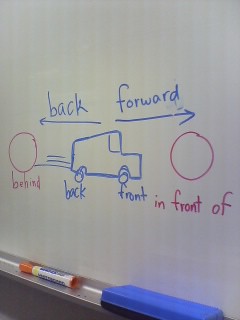スミス英会話大津校の日本語のサイトはこちら
英会話無料レッスンはこちら
My love for the whiteboard has been growing ever since I started at Smith’s School of English in Ohtsu (スミス英会話大津). The Smith’s curriculum encourages using the whiteboard and through the soapbox and curriculum seminars I have learned a variety of ways of using the whiteboard to maximize student learning potential and also mix things up, making the lessons more enjoyable.



A basic use is to write new vocabulary and sentence structure on the board. Within the Smith’s curriculum we use the whiteboard to write the lesson title and to let students know when we are changing from one lesson to another.
For correcting student errors, the whiteboard is an invaluable tool. I like to write a few sentences on the board and have students come up to the board and correct them themselves. If they are stuck, it’s easy to underline the mistake or write a similar structure for comparison. Once the sentence is correct, remove the underlines and other marks and have the student write the clean, mistake-free sentence in their notebooks. An example I often encounter is first person/ third person mix-ups. Knowing how-to use the whiteboard to help students see this problem and understand the difference between first and third person is very important. I will show this to students by writing 4 or 5 similar sentences with the verbs in present from in brackets: Where (do) I (live)? You (live) between Zeze膳所 and Ishiyama石山. Where (do) he (live)? He (live) between Zeze膳所 and Otsu大津. Where (do) Kanoko (eat) lunch? She (eat) lunch at Hiro Bakery. Then I have students write the correct verb form.



For vocabulary, idiom, and phrase lessons, it is quick and easy to simply write 2 lists on the board and have students come up and draw lines connecting the left and right columns. For example: write a list of vocabulary words as the left column and a list of synonyms as the right column (mixed up) and have students connect left and right. Other ideas: example sentences, antonyms, verb form/noun form/adjective form/adverb form, associated objects, and so on.
For some lessons, a visual explanation is easier and quicker than trying to explain a concept (especially for low level students). A simple drawing, graph, timeline, or chart can effectively convey meaning. For example when explaining “dawn/dusk” I like to draw a timeline with words along the bottom and pictures along the top. On the bottom I write night->dawn->sunrise->morning->noon->afternoon->evening->sunset->dusk->night. On the top I draw stars, then no stars, then the sun rising, then the sun in the sky… etc.
Knowing how to use the whiteboard is key to being a good teacher of any subject, especially foreign languages (i.e. TESL and TEFL) Do you have more helpful whiteboard tips? Please post them in the comments box below.
Edward, SSE Ohtsu
エドワード、スミス月謝制英会話大津校
Wish I had your artistic talent…while I use the whiteboard constantly I try to stay away from drawings as I tend to ridiculed (in a nice way). Used correctly the whiteboard is truly a teacher’s best teaching tool.
Adrian
Edward,
Your artwork is excellent. Also, I like your explanation of how you use the white board. I also use the white board to show examples and sometimes ask the students to make the corrections too. The phrase lessons especially are well presented using the white board. I just had a new idea, I can dictate a part of the phrase lesson to one of the students and have him or her write it on the white board. The next part can be done by the other student and then we can start working with the Japanese cards and the English cards to find the missing words. There are so many ways to use the white board to make the lessons more effective.
Great examples! Keep up the good work!
Al, SSE Okamoto